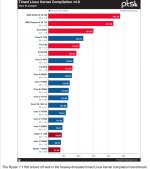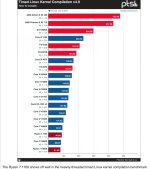So no IPC benefit then. Threadripper will destroy this.
http://www.anandtech.com/show/11550...core-i9-7900x-i7-7820x-and-i7-7800x-tested/16
http://www.anandtech.com/show/11550...core-i9-7900x-i7-7820x-and-i7-7800x-tested/16
Please remember that any mention of competitors, hinting at competitors or offering to provide details of competitors will result in an account suspension. The full rules can be found under the 'Terms and Rules' link in the bottom right corner of your screen. Just don't mention competitors in any way, shape or form and you'll be OK.
So no IPC benefit then. Threadripper will destroy this.
http://www.anandtech.com/show/11550...core-i9-7900x-i7-7820x-and-i7-7800x-tested/16
So no IPC benefit then. Threadripper will destroy this.
http://www.anandtech.com/show/11550...core-i9-7900x-i7-7820x-and-i7-7800x-tested/16

I like this slide

You could buy x2 ryzen 1700's versus the 7900x. Get the same amount of compiling done and whilst using less energy, cheaper motherboards and on stock coolers.
Don't tell me, they used intels compiler
Side note, it would be nice if they showed how they derived said benchmark, as in what they used compiler wise, flags ect
Thats a very bad slide for AMD, the performance there is absolutely atrocious. thats really really really bad, there is almost no difference between the cheapest 6 core and the best 8 core indicating this program just doesn't scale at all with AMD, its only scaling with Mhz, not threads.
Infact i suspect with this even the 4 core Ryzen 3 would look the same as the rest of the Ryzen chips.
If anyone ever wanted to drive home an agenda of how bad AMD's performance is this is the slide they would use as its little more than half as fast as Intel's old 8 core. that is bulldozer 2.0 if anyone was looking for such a thing.
Thats a very bad slide for AMD, the performance there is absolutely atrocious. thats really really really bad, there is almost no difference between the cheapest 6 core and the best 8 core indicating this program just doesn't scale at all with AMD, its only scaling with Mhz, not threads.
Infact i suspect with this even the 4 core Ryzen 3 would look the same as the rest of the Ryzen chips.
If anyone ever wanted to drive home an agenda of how bad AMD's performance is this is the slide they would use as its little more than half as fast as Intel's old 8 core. that is bulldozer 2.0 if anyone was looking for such a thing.

Thing is, in Linux and GCC Ryzen doesn't have that issue. This is launch day reviews results and look how well it does there.
I wonder what compiler Anandtech was using.
http://www.phoronix.com/scan.php?page=article&item=amd-ryzen-1700&num=4

First, the 7900X is never faster than the 6950X in the gaming tests we ran, although it is able to match performance in Ashes, Deus Ex: Human Revolution, Ghost Recon Wildlands, and GTA V (mostly). However, take a look at Civ 6, Far Cry Primal, or even Hitman and Rise of the Tomb Raider: these show the new 7900X as slower than the 6950X in gaming, even with its substantial clock speed advantages. How? Remember back to this graph I showed you on thread-to-thread communication latency?
Wow:
https://www.pcper.com/reviews/Proce...X-Processor-Review/Thread-Thread-Latency-and-
Inter-chip latency is pretty high!!
Gonna be an interesting story I think with some of the upcoming CPUs and inter-chip latency. For big data tasks it isn't too much of an issue but for stuff like gaming can be another matter.
EDIT: Oh they do actually touch on that later on in the article:
It is something people probably will want to keep a close eye on especially if they have multi die CPUs in mind for gaming.
In a slightly different and more complex way it is why you don't tend to see GPUs forever rehashing the same architecture with ever increasing SP counts.
The good element of this design is that a larger L2 will increase the hit-rate and decrease the miss-rate. Depending on the level of associativity (which has not been disclosed yet, at least not in the basic slide decks), a general rule I have heard is that a double of cache size decreases the miss rate by the sqrt(2), and is liable for a 3-5% IPC uplift in a regular workflow. Thus here’s a conundrum for you: if the L2 has a factor 2 better hit rate, leading to an 8-13% IPC increase, it’s not the same performance as Skylake-S. It may be the same microarchitecture outside the caches, but we get a situation where performance will differ.
Nope, smash your head against a wall get concussion and order bundle twice expensive than AMD with little to no benefit at all. sarcasm offSo for 6 core wait for Coffee Lake and for multi-threaded wait and see what Threadripper brings.
Does that sound about right?

If CoffeeLake brings some nice IPC gains and 6 cores, 12 threads, I wouldn't touch the lower end Skylake X chips at all.So for 6 core wait for Coffee Lake and for multi-threaded wait and see what Threadripper brings.
Does that sound about right?
Remember that code optimisations could improve matters, just as with Ryzen.It's the cause of RyZen's lower gaming performance as well, yet even with that competes well against Broadwell, despite lower clocks.
Here Skylake X is losing to Broadwell-E while being clocked much higher. It's like an IPC decrease in gaming nearly.
To think people and even Anandtech thought this new cache structure could provide nearly up to a 13% IPC increase. Yeah... So far it seems Skylake X only beats Broadwell-E in compute because of its drastically increased clock rates, and then losing in games despite higher clocks. So one can say a decrease in IPC nearly.
http://www.anandtech.com/show/11464...ng-18core-hcc-silicon-to-consumers-for-1999/3
Why do people still expect IPC gains? It's a hex core Core i7-7700K.If CoffeeLake brings some nice IPC gains and 6 cores, 12 threads, I wouldn't touch the lower end Skylake X chips at all.
Not with them performing worse in games than Broadwell and Kabylake
Must admit the i7 7820 looks like a bit of a monster and only 80 odd quid more than the Ryzen 7 8 core, as I currently have a 5930k i'm not looking to upgrade for a good while yet, but I'm looking forward to what threadripper has to offer.
Why do people still expect IPC gains? It's a hex core Core i7-7700K.

